Тайная вечеря. XVI век
Работы XVI века - века перемен. Картины, эмаль, мексиканское перо, шпалера и т.д.
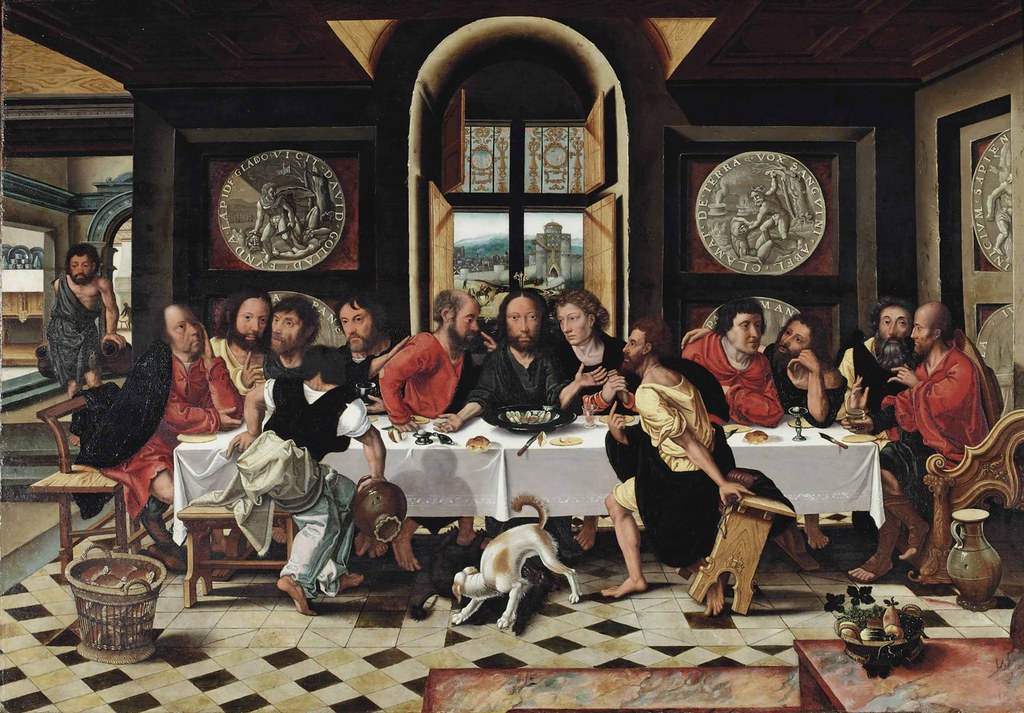
«Тайная вечеря». Мастерская Питера Кука ван Альста / Studio of Pieter Coecke van Aelst I (Aelst 1502-1550 Brussels). The Last Supper. Dated '1539' (on the medaillon, centre left). Oil on panel. 78.5 x 111 cm. Price Realized €109,500 ($143,384). Estimate €40,000 - €60,000 ($52,466 - $78,699). 7 May 2013. Amsterdam. Christie's. Source / About 50 versions of this composition are known, most of them from the workshop of Coecke van Aelst. Most are dated, of which the present work carries the date 1539. [Lot Description]
Description
Provenance
(Possibly) Bayer, Elberfeld, Wuppertal, before 1911.
Literature
L. Ninan, 'Un "Christ et les Disciples d'Emmaüs" dans le style de Pierre Coecke', Musees Royaux des Beaux-Arts Bulletin, II, March 1953, p. 8.
G. Marlier, Pierre Coeck d'Alost, Brussels, 1966, p. 98, no. 33.
M. J. Friedländer, Early Netherlandish Painting, XII, Leiden, 1975, p. 36.
Lot Notes
Pieter Coecke van Aelst's Last Supper was one of the most popular images of the 16th century. It freely combines the compositions of Leonardo da Vinci's Last Supper in Milan (1498) and Marcantonio Raimondi's engraving after Raphael's drawing of the same subject (circa 1510-20) and with the enigmatic gestures of the apostles from the popular print by Albrecht Dürer (1523). The scene with Cain and Abel on the medaillon on the right, is taken directly from a print by another popular Renaissance artist, Jan Gossaert, called Mabuse (active 1503-32).
About 50 versions of this composition are known, most of them from the workshop of Coecke van Aelst. Most are dated, of which the present work carries the date 1539. The painting accurately follows the composition of Pieter Coecke van Aelst's Last Supper. The inclusion of specific details such as the ornaments in the windows and the text in the medaillons shows that the painter was well acquainted with the original composition. The most notable difference between the present version and the others are the apostles' heads which differ in style and size from Coecke van Aelst. This variation of the heads - some of them are possibly portraits - points towards a 'customized' serial product. More than one hand can be distinguished in the present painting: the heads on the left and right clearly differ in quality. The specific likenesses and other details here are likely due to the request of the patron of this work.
We are grateful to Drs. Linda Jansen for her assistance in cataloguing this lot, after inspection of the original (written communication 4 March 2013).
Ренессансная новомодная «Тайная вечеря» Питера Кука ван Альста стала одним из самых популярных изображений XVI века на этот сюжет.
Известно около полусотни версий подобных картин, в основном происходящих из мастерской Питера Кука ван Альста. Большинство из них датированы 1527-1550 годами, из которых шесть или семь версий содержат раннюю дату 1528 - исключительно продуктивный год.
Вот одна из таких работ 1528 года:
2.

Pieter Coecke van Aelst and Studio Aelst 1502-1550 Brussels. The Last Supper. Dated 'ANNO 1528' (on the medals, center). Oil on panel. 61.3 x 81 cm. Price realised USD 56,250. Estimate USD 20,000 - USD 30,000. 28 January 2009, New York. Christie's. Source / This can be measured by the many versions: an impressive forty-five are known today. A great number are dated, of which six or seven versions carry the early date 1528, making it an exceptionally productive year.
Питер Кук ван Альст в свой «Тайной вечери» свободно миксует Леонардо да Винчи, Рафаэля, Альбрехта Дюрера.
Сцена с Каином и Авелем, что в тондо на стене, взята непосредственно из ксилографии другого известного художника эпохи Возрождения - нидерландца Яна Госсарта по прозванию Мабюз (активен 1503-1532) / Jan Gossaert, called Mabuse (Netherlandish, c.1478-1532).
Библейские сцены, изображенные на заднем плане, усиливают воздействие основной темы. Через окно видим арку в типичном антверпенском стиле со сценой входа Христа в Иерусалим - эпизод Страстей, предшествующий Тайной Вечере. В орнаментированном окне вроде бы должно быть изображено Грехопадение (я не вижу). В медальонах: истории победы Давида над Голиафом и убийства Каина. Вся иконография сосредоточена на первородном грехе и спасении человечества через жертву Христа.
Актуальные ренессансные мотивы и иконографическая сложность способствовали популярности композиции: 50 живописных копий за четверть века - практически тиражное производство.
3.

Около 1515-1516. Тайная вечеря. Гравюра Маркантонио Раймонди (ок. 1470-1482 - ок. 1534) по рисунку Рафаэля Санти (1483-1520) / The Last Supper. Artist/Maker: Raimondi, Marcantonio (engraver). Raphael, born 1483 - died 1520 (artist). Date: ca. 1515-1516 (made). Engraving. Print. Italy (probably, made). Museum number: DYCE.1007. Victoria and Albert Museum, London Source / The source for the print is thought to be Raphael’s drawing of the same subject in the Royal Library at Windsor Castle. Marcantonio collaborated with Raphael for about a decade from 1510, basing his engravings on Raphael’s drawings for frescos or paintings. Since Raphael made no fresco or painting of this subject, this drawing may have been specifically made as a model for Marcantonio’s engraving. The collaboration between the two artists was mutually beneficial since Marcantonio’s engravings helped to spread Raphael’s fame throughout Europe.
Один из источников вдохновения для Питера Кука ван Альста - гравюра Маркантонио Раймонди по рисунку Рафаэля.
4.

The Last Supper. Albrecht Dürer (German, Nuremberg 1471-1528 Nuremberg). 1523. Woodcut. 21.3 x 14.6 cm. Prints. Accession Number: 22.111.1. The Metropolitan Museum of Art. Source
Еще один источник для «производства» пользующейся спросом «Тайной вечери» - добавить выразительных деталей и жестов из известной гравюры Дюрера 1523 года. [Для сравнения - вариант ксилографии Дюрера - 1509/1510 года]
Секрет успеха, актуальный во все времена, не только в XVI веке: берем все самое модное, хорошо продаваемое и замешиваем в одно.
Произведения XVI века из разных материалов и стран на сюжет Тайной вечери:
5.

The Institution of the Eucharist at the Last Supper with St. Peter and St. Paul. Mid-16th century. Made in Mexico. Culture: Mexican. Medium: Feathers and colored paper on wood, gilt wood frame. Dimensions: 48.3 x 15.9 cm. Center 48.3 x 31.8 cm. Classification: Natural Substances. Accession Number:88.3.1. The Metropolitan Museum of Art. Source / This feather mosaic triptych from 16th-century Mexico is one of just three that survive. [It was created by indigenous featherworkers]It was created by indigenous featherworkers who adapted the pre-Hispanic technique to Christian use. An altar card, it pictures the Last Supper as the first Mass. The Latin text beneath the image begins: “For this is my body. For this is the chalice of my blood.”
Feather mosaics were highly prized by Europeans for their exotic origin and appearance. The present work, which can be traced to a Florentine collection, was among the “objects of curious pictorial art” given to the Museum in 1888 by a Manhattan law firm.
Signatures, Inscriptions, and Markings
Inscription: Hoc est enim corpus meus / Hic est enim calix saguinis / mei novi et eterni testamenti / mysterium fidei: effundetur in re / missionem peccatorum
(For this is my body. For this is the chalice of my blood of the new and eternal testament, the mystery of the faith which shall be shed for you and for many for the remission of sins)
Мексиканское птичье перо.
Учреждение Евхаристии на Тайной Вечере со святыми Петром и Павлом. Алтарь сделан в Мексике в середине XVI века из перьев и раскрашенной бумаги. Основа и позолоченная рама - деревянные.
Этот мексиканский триптих из пера - один из трех сохранившихся до нашего времени. Он был изготовлен коренными жителями Мексики, которые приспособили доиспанскую технику к христианским нуждам.
6.

Фрагмент. Source
Алтарь изображает Тайную Вечерю как первую Мессу. Латинский текст под изображением гласит: Cие есть Тело Мое. Cие есть Кровь Моя Нового Завета, за многих изливаемая во оставление грехов / «Hoc est enim corpus meus / Hic est enim calix saguinis / mei novi et eterni testamenti / mysterium fidei: effundetur in re / missionem peccatorum».
Мозаика из пера высоко ценилась европейцами за экзотичность материала и необычный внешний вид. Произведение, сейчас находящееся в Музее Метрополитен, вероятно, происходит из флорентийской коллекции.
7.

Пластина 'Тайная вечеря'. Место создания: Франция, Лимож. Середина XVI в. Материал: медь, Эмаль, бронза. Техника: роспись полихромная с частичной подложкой из фольги, золочение, контрэмаль прозрачная. Размеры: 27,2 х 21,2 см. Поступление: Поступил в 1925 г. Передан из дома-музея Е.В. Шуваловой. Инвентарный номер: Ф-2638. Государственный Эрмитаж. Source
Лиможская эмаль.
8.

Пластина 'Тайная вечеря', форгмент. Лимож. Середина XVI в. Эрмитаж
9.

Пластина 'Тайная вечеря', форгмент. Лимож. Середина XVI в. Эрмитаж
10.

Шпалера. Около 1524-1546 - дизайн, около 1525-1528 - изготовление / The Last Supper. Designed by Bernard van Orley (Netherlandish, Brussels ca. 1492-1541/42 Brussels). Artist: Probably woven by Pieter de Pannemaker (Netherlandish, active 1517-1535). Ca. 1524-46 (design), ca. 1525-28 (woven). Wool, silk, silver-gilt thread. 335 x 350 cm. Textiles-Tapestries. Accession Number: 1975.1.1915. The Metropolitan Museum of Art. Source / This splendid Last Supper is part of a series of four tapestries, designed about 1520, illustrating the Passion of Christ and possibly woven for the duke of Alba. [Designed by Bernaert van Orley...]Designed by Bernaert van Orley, who was court painter to Margaret of Austria, the scene is set in an elaborate Italian Renaissance loggia, through which other classically inspired building are visible in the background. The love of decorative detail evident in the marble piers, the patterned tablecloth, and the fictive wall hangings signal the Flemish taste for rich surface ornament. With his enormous nimbus, Christ is shown at the center of the composition with his right arm around the sleeping Saint John and his outstretched left arm directing the viewer's eye toward Judas, who rises to leave in the lower right, his purse already filled with the payment he has received for his promised betrayal.
Several details in the Last Supper suggest it was conceived with a Protestant interpretation. The paschal lamb is absent and the dish at the center of the table that would have held it supports the large chalice filled with wine, reflecting the beliefs of Martin Luther, who repudiated the notion of the sacrifice of the Mass, symbolized by the slaughtered lamb, as an abomination, but supported the partaking of bread and wine. Bread has been placed on the table before the disciples, and a conspicuously placed, lavishly dressed innkeeper pours wine from a ewer into the cup of one of the apostles in the foreground. On the neckline border of Christ's robe is inscribed "MEI," a fragment of his words spoken at the breaking of bread and drinking of wine, "This do in remembrance of me." The composition as well as the poses and gestures of some of the figures are inspired by a 1510 woodcut of the Last Supper by Albrecht Dürer. Raphael’s cartoons for the tapestry series Acts of the Apostles, commissioned for the Sistine Chapel and sent to Brussels to be woven, were significant models for van Orley and other Flemish artists, providing a paradigm of the grand, heroic narrative style of contemporary Roman art. In the Last Supper, populated by muscular, rhetorically gesturing figures engaged in a moment of high drama, van Orley fully realized tapestry's potential for emulating monumental painting.
Ковер.
Шпалера, созданная примерно в 1525-1528 годах по картону Бернарта Орлея (между 1487 и 1491, Брюссель - 1541, Брюссель).
11.
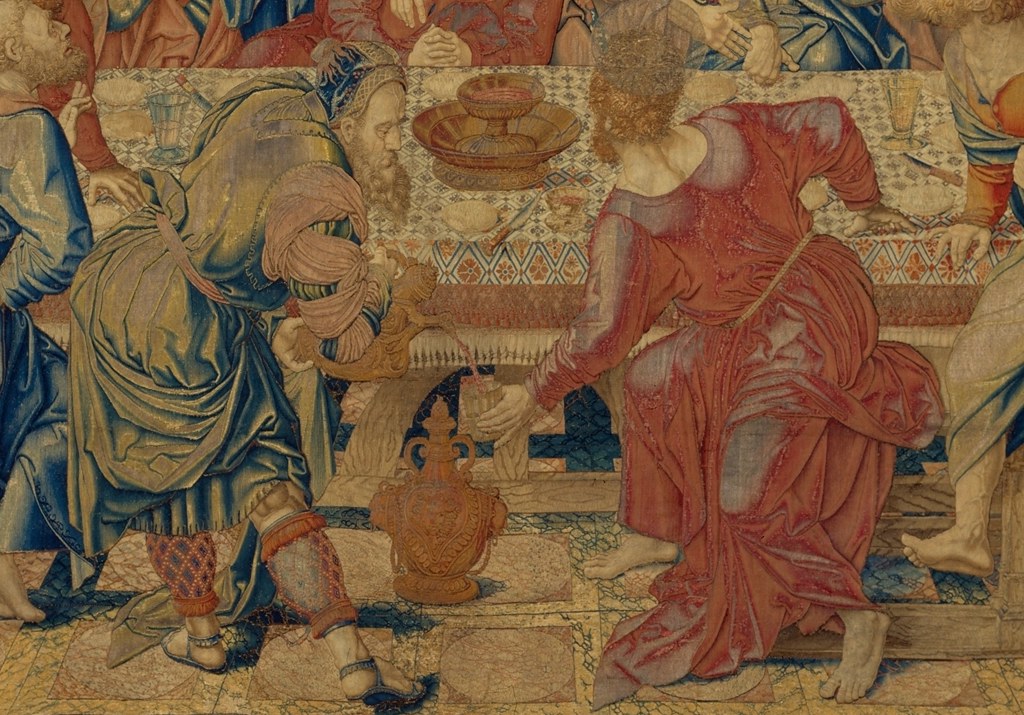
Фрагмент шпалеры
12.

Около 1500-1530. Сделано в Кёльне, Германии или Нидерландах. Известняк, следы полихромной раскраски / The Last Supper. Ca. 1500-1530. Made in Cologne, Germany or Netherlands. Culture: German or South Netherlandish. Medium: Limestone, traces of polychromy. Overall: 63.5 x 39.4 x 16.5 cm. Accession Number: 32.100.143. The Metropolitan Museum of Art. Source / This scene of the Last Supper clearly shows each disciple, including Judas, who is seen at the lower right clutching his bag of money, a reference to his future betrayal. The elaborate and detailed carving indicates that the sculpture came from an important ecclesiastical setting, such as a sacrament house that contained the elements for celebrating mass. Cologne Cathedral contained such a structure, made by the sculptor Franz Maidburg (d. 1533), which was dismantled in the nineteenth century.
Скульптура.
13.

Roundel with the Last Supper. 1515-1525. Made in Amsterdam (?), North Netherlands. Culture: North Netherlandish. Medium: Colorless glass, silver stain, vitreous paint. Overall Diam.: 20.6 cm. Glass-Stained. Accession Number: 32.24.46. The Metropolitan Museum of Art. Source
Стекло.
Витраж из Северных Нидерландов: бесцветное стекло, серебристая окраска, стекловидная краска.
14.

Около 1530-1538 г. Рукопись. Бодлианская библиотека / Book of Hours. Use of Rome (Hours of Eleonora Ippolita Gonzaga). Country or nationality of origin: Italian. Place of origin: Urbino or Mantua(?). Date: c. 1530-1538. Manuscript, Parchment. Image description: Cat and 2 dogs in foreground of scene of Last Supper. MS. Douce 29, fol. 056r. Bodleian Library. Source
Миниатюра из иллюминированной рукописи - место создания: Урбино или Мантуя (?).
Кот и две собаки как участники Тайной вечери.
Далее - станковая живопись:
15.

Около 1511. Ханс Шойфелин / Hans Leonard Schäufelein (c. 1480/1485 - 1538/1540). Das Abendmahl. © Staatliche Museen zu Berlin, Foto Jörg P. Anders
Германия, около 1511.
18.

The Last Supper. Artist: Netherlandish (Antwerp Mannerist) Painters (first quarter 16th century). 1515-1520. Oil on wood. Dimensions: Overall, with shaped top and engaged frame: central panel 119.4 x 85.7 cm; left wing 119.4 x 42.9 cm; right wing 119.7 x 43.2 cm. Accession Number: 17.190.18a-c. The Metropolitan Museum of Art. Source / At least three artists collaborated on this well-preserved altarpiece, which is still in its original (though regilt) frame. [Adam and Eve on the exterior are base]Adam and Eve on the exterior are based on Dürer's 1504 engraving of the subject. The Old Testament scenes on the inner wings are prefigurations of the Last Supper, which is depicted in a fantastic Renaissance architectural setting on the central panel. The left wing shows the king and high priest Melchizedek outside the gates of Salem giving bread and wine to the patriarch Abraham. The right wing represents Moses and the Israelites in the desert fed by manna falling from heaven.
Signatures, Inscriptions, and Markings
Inscription: Inscribed (on frame): (under left wing) CENANTIBVSILLIS, ACZEPIT; (under central panel) IESVS PANEM BENEDIXIT, ACFREJIT, DEDITQV[E]; (under right wing) DISCIPVLIS, SVIS, DICENS (And as they were eating, Jesus took bread, and blessed it, and brake it, and gave it to the disciples, and said . . . [Matthew 26:26].); (right wing, on tent in background) AVE MARIA . . .
Нидерландская живопись, 1515-1520.
16.

Около 1562. Хуан Висенте Масип, более известный как Хуан де Хуанес. Испания / Joan de Joanes. The first Eucharist / Juan de Juanes. La Última Cena. Hacia 1562. Óleo sobre tabla, 116 x 191 cm. Museo Nacional del Prado. Source
Испания, около 1562.
Из «Словаря эпохи Возрождения»[*]:
" Месса
Центральная часть католического культа, во время которой вновь совершаются последняя трапеза и жертва Христа. Месса с самого начала стала предметом критики со стороны Лютера, а вслед за ним и всех протестантов. Они видели в ней проявление суеверия и полностью отрицали спасительную роль таинства, на которой настаивала католическая Церковь, так как, с точки зрения протестантов, спастись можно только верой. Споры шли также о смысле таинства: о реальном присутствии Тела и Крови Христа в евхаристии под видом хлеба и вина. В католической Церкви утвердилась доктрина о пресуществлении, согласно которой хлеб и вино реально становятся Телом и Кровью Христа. Лютер верил в реальное присутствие, но в виде консубстанциации, т. е. сосуществования Тела и Крови Христа с хлебом и вином. Цвингли отрицал реальное присутствие и считал евхаристию символическим актом (приверженцев такой позиции стали называть сакраментариями). Кальвин колебался между позициями Лютера и Цвингли, склоняясь скорее к Лютеру, но позднее реформатские церкви Швейцарии приняли позицию сакраментариев. Католическая Церковь в свою очередь приняла на Тридентском соборе догмат о реальном присутствии.
17.

Фрагмент. Подписанные нимбы / Juan de Juanes. La Última Cena. Hacia 1562. Museo Nacional del Prado. Source
Известно, что Франциска I привели в ярость листовки, развешенные в Париже и на дверях королевской опочивальни в Блуа в 1534 г. В них содержались нападки на «отвратительную римскую мессу», на которой король Франции присутствовал ежедневно. "
19.
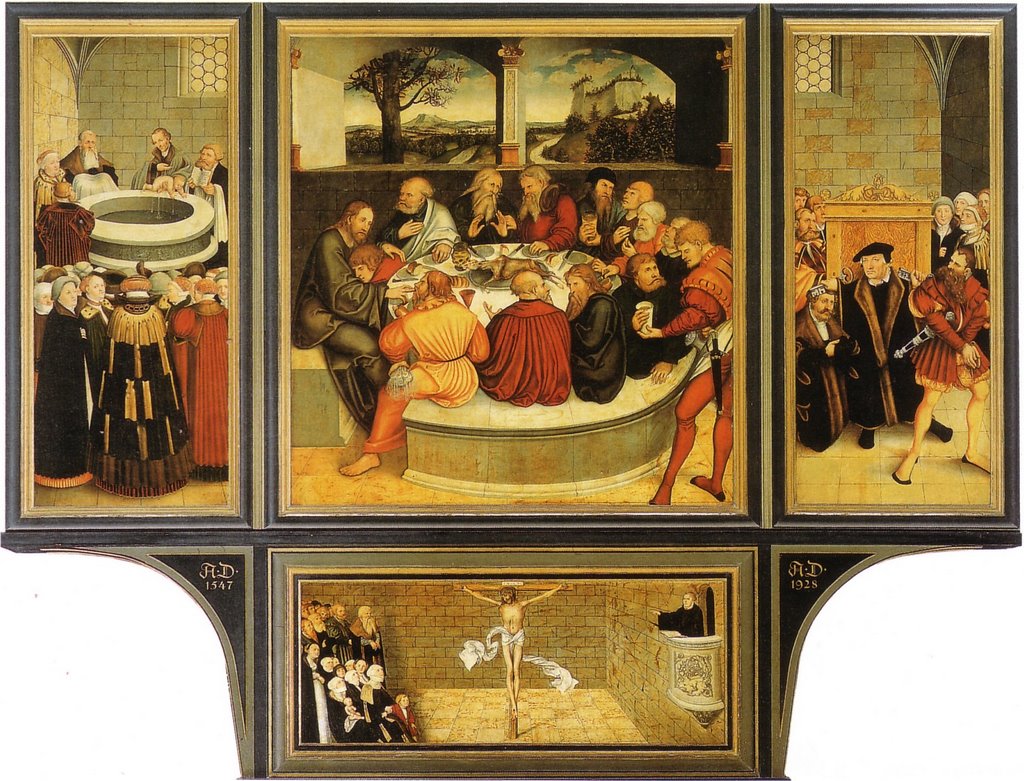
1547 год, Виттенберг, Мариенкирхе. Лукас Кранах Старший /Lucas Cranach der Ältere (1472-1553) / Reformation altarpiece by Lucas Cranach the Elder in the Stadtkirche St Marien, Wittenberg. Вид алтаря в интерьере
Хрестоматийный протестантский алтарь Лукаса Кранаха Старшего. На центральной части алтаря виттенбергской городской церкви Святой Марии /Мариенкирхе XVI века, в которой часто проповедовал Лютер, изображена Тайная Вечеря с Мартином Лютером среди апостолов.
Из «Словаря эпохи Возрождения»[*]:
" Вечеря Господня
Воспоминание о последней трапезе Христа с учениками, на которой Он возвестил о Своей спасительной смерти и установил Евхаристию; этим термином пользуются протестантские церкви вместо «мессы»; по сравнению с прежним обрядом церемония упрощена, центральное место в ней занимают чтение Слова Божьего и молитва перед воспоминанием о последней трапезе Христа и причастием (в кальвинистских церквах четыре раза в год). "
20.

1565 год. Лукас Кранах Младший (1515-1586). Алтарь Замковой церкви в Дессау, 1565. В виде апостолов изображены протестанские теологи и князья. via / Among the seated guests were Luther, Melanchton and other prominent reformators / Epitaph for Prince Joachim of Anhalt. 1565. Lucas Cranach the Younger. Ev. Kirchgemeinde St. Johannis und St. Marien, Dessau. 257.5 x 209. Lime wood. Signature/Date: Artist's insignia bottom left winged serpent with dropped wings, facing left, and dated '1565'. From the church of St. Marien, Dessau. Since 1992 in the Johanniskirche, Dessau. Source
Не менее хрестоматийное произведение Лукаса Кранаха Младшего - алтарь замковой церкви в Дессау, 1565.
21.

Фрагмент / Epitaph for Prince Joachim of Anhalt. 1565. Lucas Cranach the Younger. Ev. Kirchgemeinde St. Johannis und St. Marien, Dessau. Source
Здесь видные деятели Реформации, а также знатные и состоятельные протестантские «светские авторитеты» изображены на Тайной Вечере в качестве Апостолов и свидетелей события. «Апостолы» могут(?) быть идентифицированы так: слева (по правую руку Христа; от Иисуса - к концу стола): Георг фон Анхальт [? Князь Георг III фон Анхальт-Дессау (1507-1553)], Лютер (указывает на Христа рукой, но его взгляд где-то блуждает), Йоханнес Бугенхаген, Юстус Йонас, Каспар Круцигер. По левую руку Христа: Филипп Меланхтон, Иоганн Форстер, Иоганн Пфеффрингер, Георг Майор и Бартоломеус Бернхарди. [Перечень отсюда: 1, 2]
22.
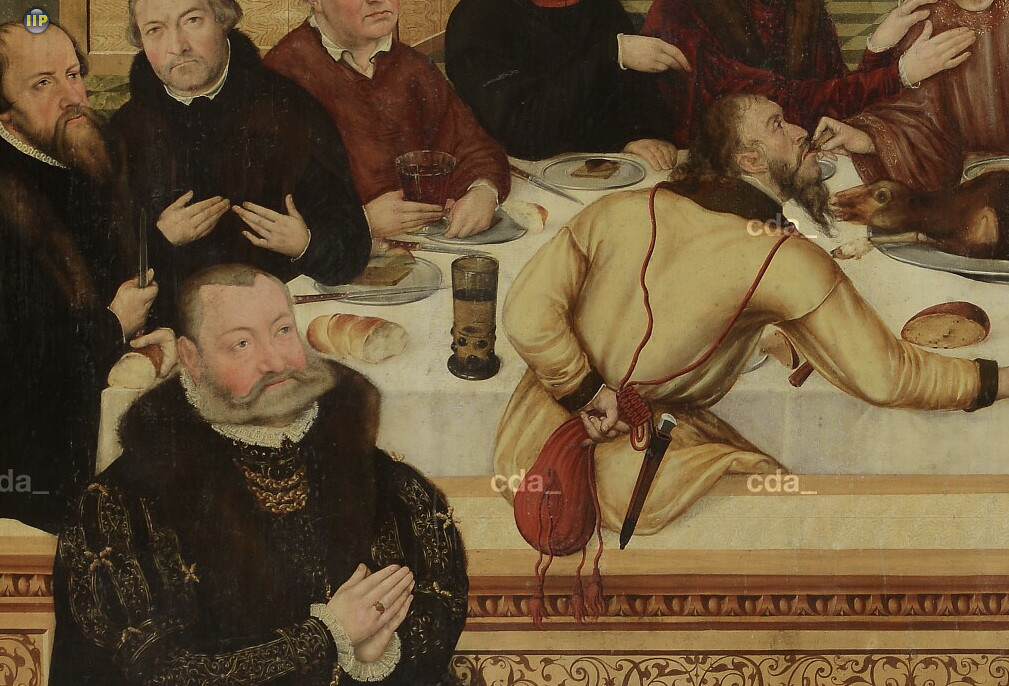
Фрагмент / Epitaph for Prince Joachim of Anhalt. 1565. Lucas Cranach the Younger. Ev. Kirchgemeinde St. Johannis und St. Marien, Dessau. Source
На переднем плане слева коленопреклоненный - Иоахим фон Анхальт /Duke Joachim of Anhalt.
23.

Фрагмент / Epitaph for Prince Joachim of Anhalt. 1565. Lucas Cranach the Younger. Ev. Kirchgemeinde St. Johannis und St. Marien, Dessau. Source
Рядом с большим чаном воды, в котором охлаждается бутыль с вином стоит виночерпий. Он подает напитки участникам трапезы. Перстень на левой руке говорит, что этот персонаж может являться автопортретом Лукаса Кранаха Младшего.
24.
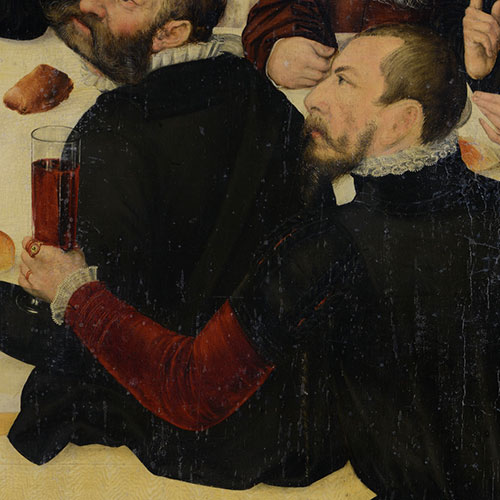
Принято считать автопортретом Лукаса Кранаха Младшего.
25.
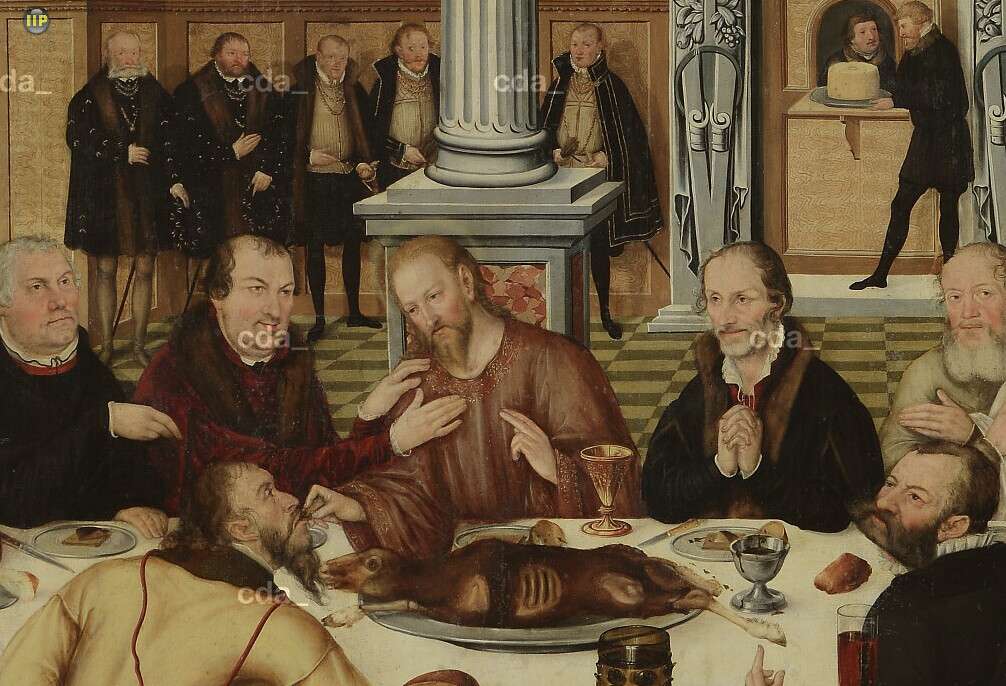
Фрагмент / Epitaph for Prince Joachim of Anhalt. 1565. Lucas Cranach the Younger. Ev. Kirchgemeinde St. Johannis und St. Marien, Dessau. Source
Официальное описание проекта Lucascranach.org, в нем отсутствует перечень «Апостолов»:
Epitaph for Prince Joachim of Anhalt. 1565. Lucas Cranach the Younger.
The painting depicts the Last Supper, whereby leading representatives of the reformation replace the apostles. Only Judas is shown separated, seated at the side of the table, Christ serves him something to eat. Set apart from the event by the front bench Duke Joachim of Anhalt kneels in the foreground wearing sumptuous robes and with his hands in an attitude of prayer. Standing beside a large bowl of water a cupbearer serves cold drinks and offers them to the participants of the dinner party. The signet ring on his left hand suggests, that this may be a self-portrait of Lucas Cranach the Younger. At the back of the stately renaissance room stands a group of five men, that have been identified as members of the Anhalt ducal house. On the right further dishes are handed to a servant through a service hatch. [Görres, cda 2013]
26.

The Last Supper [Epitaph for Prince Joachim of Anhalt]. After 1565. Follower of Lucas Cranach the Younger. Dimension of painted surface: 248 x 200 cm. Signature/Date: None. Ev. Kirche St. Agnus, Köthen. Source
Фрагмент аналогичной работы, но другой - копии Тайной вечери Лукаса Кранаха Младшего - из города Кётена, из церкви Святой Агнессы / Ev. Kirche St. Agnus, Köthen.
27.
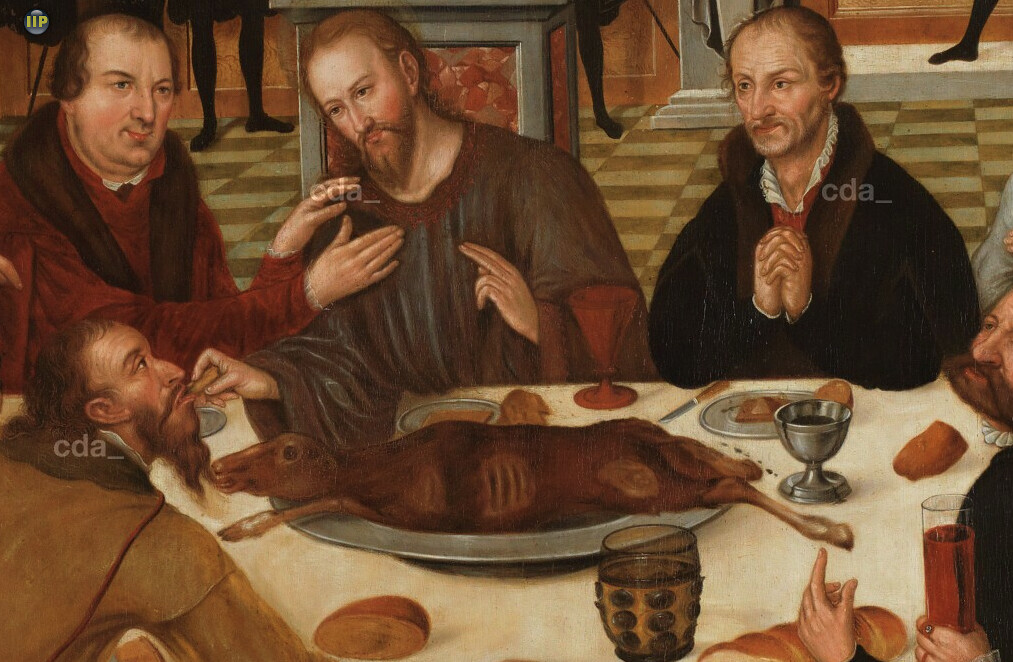
The Last Supper [Epitaph for Prince Joachim of Anhalt]. After 1565. Follower of Lucas Cranach the Younger. Dimension of painted surface: 248 x 200 cm. Ev. Kirche St. Agnus, Köthen. Source
Две цитаты из:
[*] Словарь эпохи Возрождения / отв. ред. Рене Суриак. Перевод с фр. яз. Л. А. Пименовой. - Москва: РОССПЭН, 2012. Стр. 25, 110-111.
Ранее:
Тайная вечеря от Римской Империи до Реформации, 2016-04-27 и 2014-04-17.
Тайная вечеря в миниатюрах рукописей XII-XVI веков, 2015-04-09
Вино, хлеб, рыба, овощи. О еде ромеев, 2015-10-26
Тайная вечеря китайского художника Цзэн Фаньчжи /Zeng Fanzhi, 2001 и другие его картины, 2014-02-04